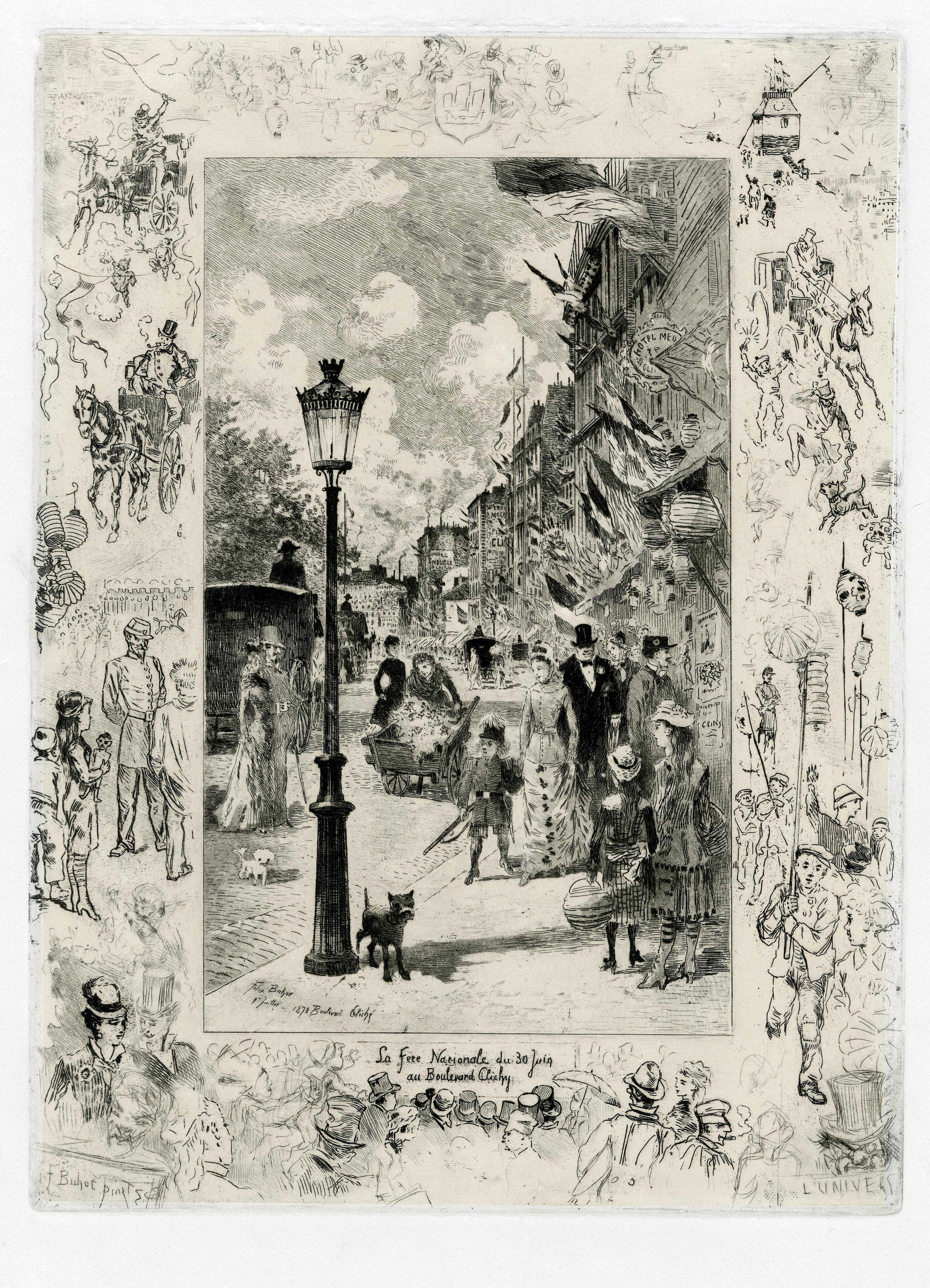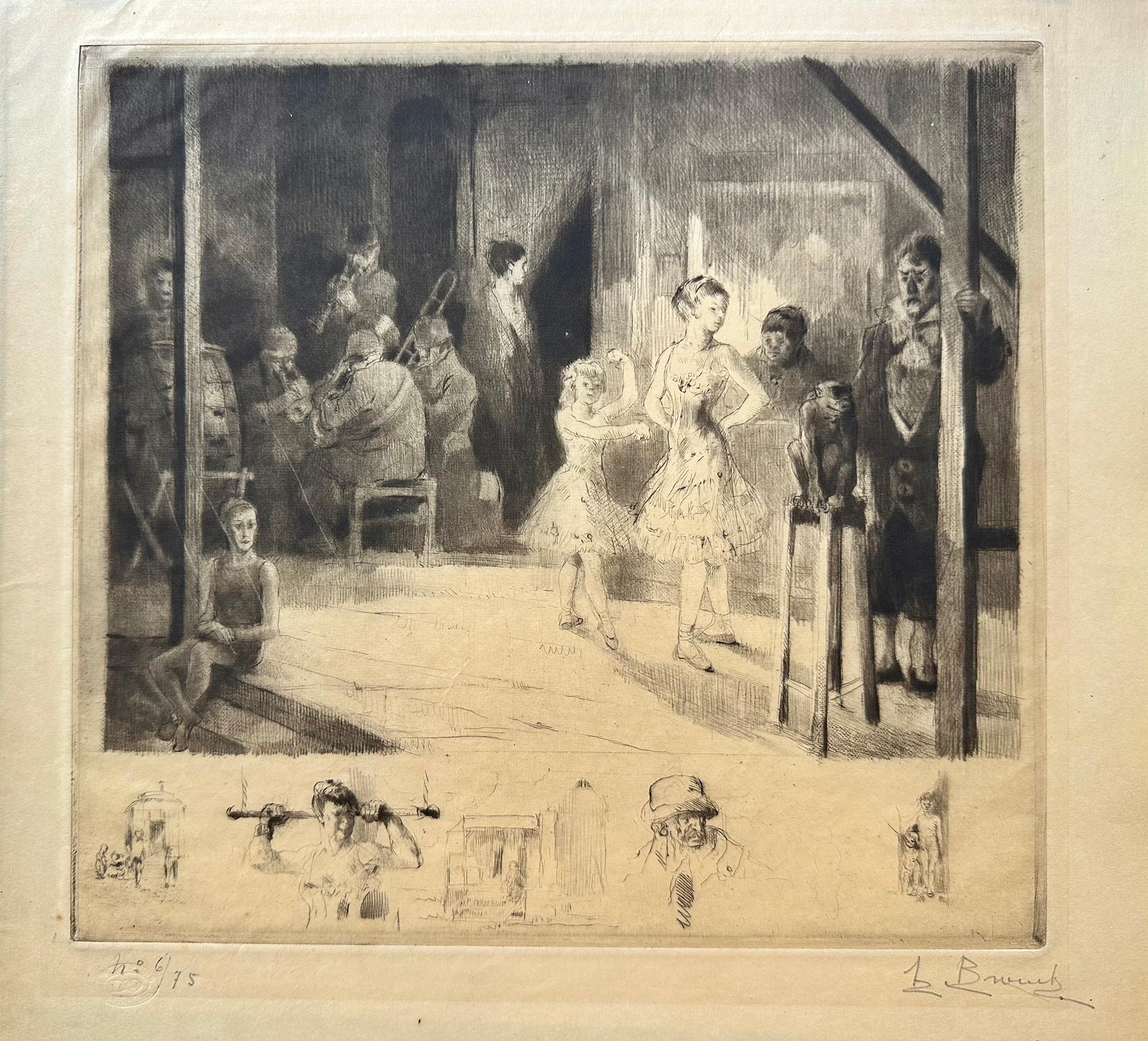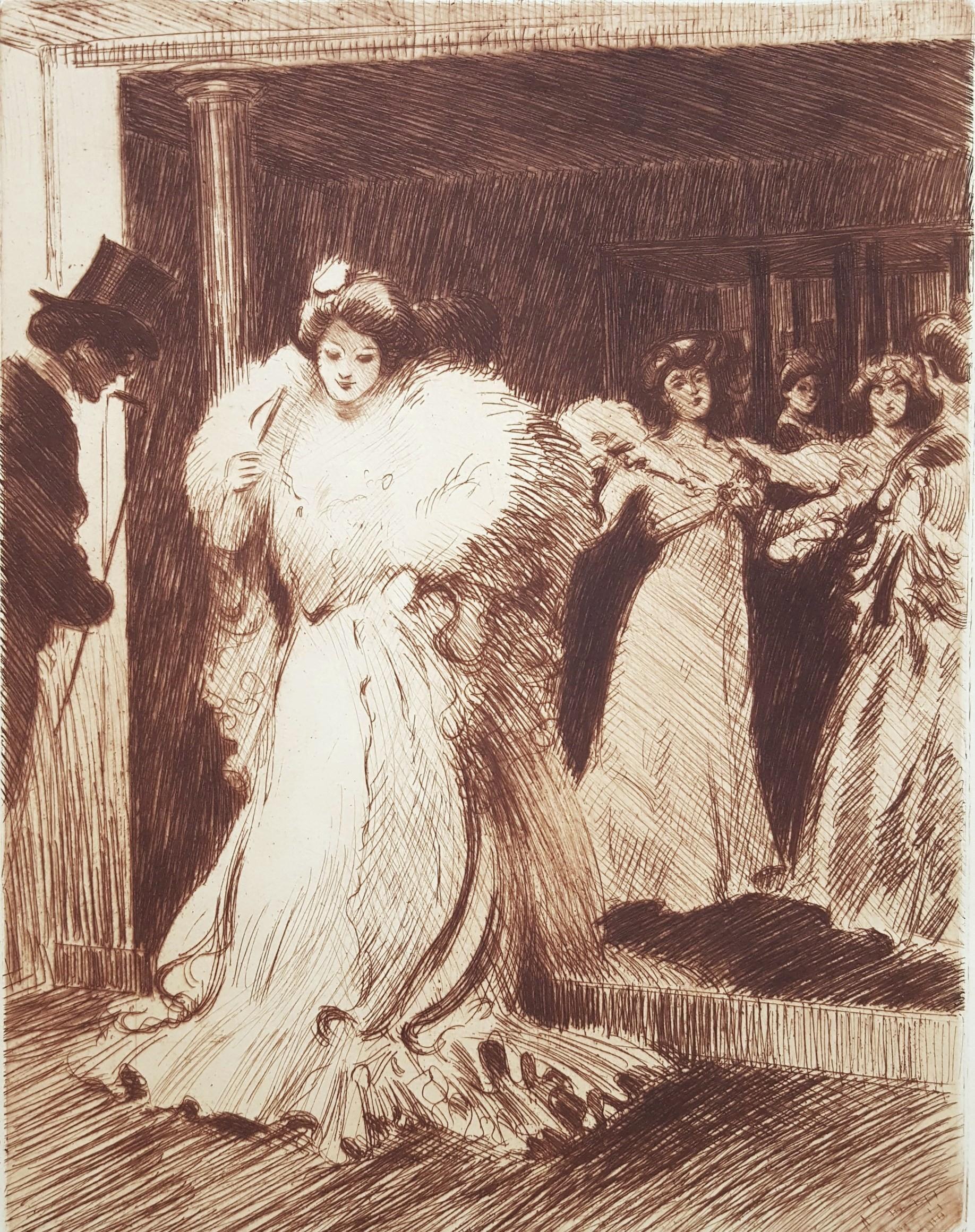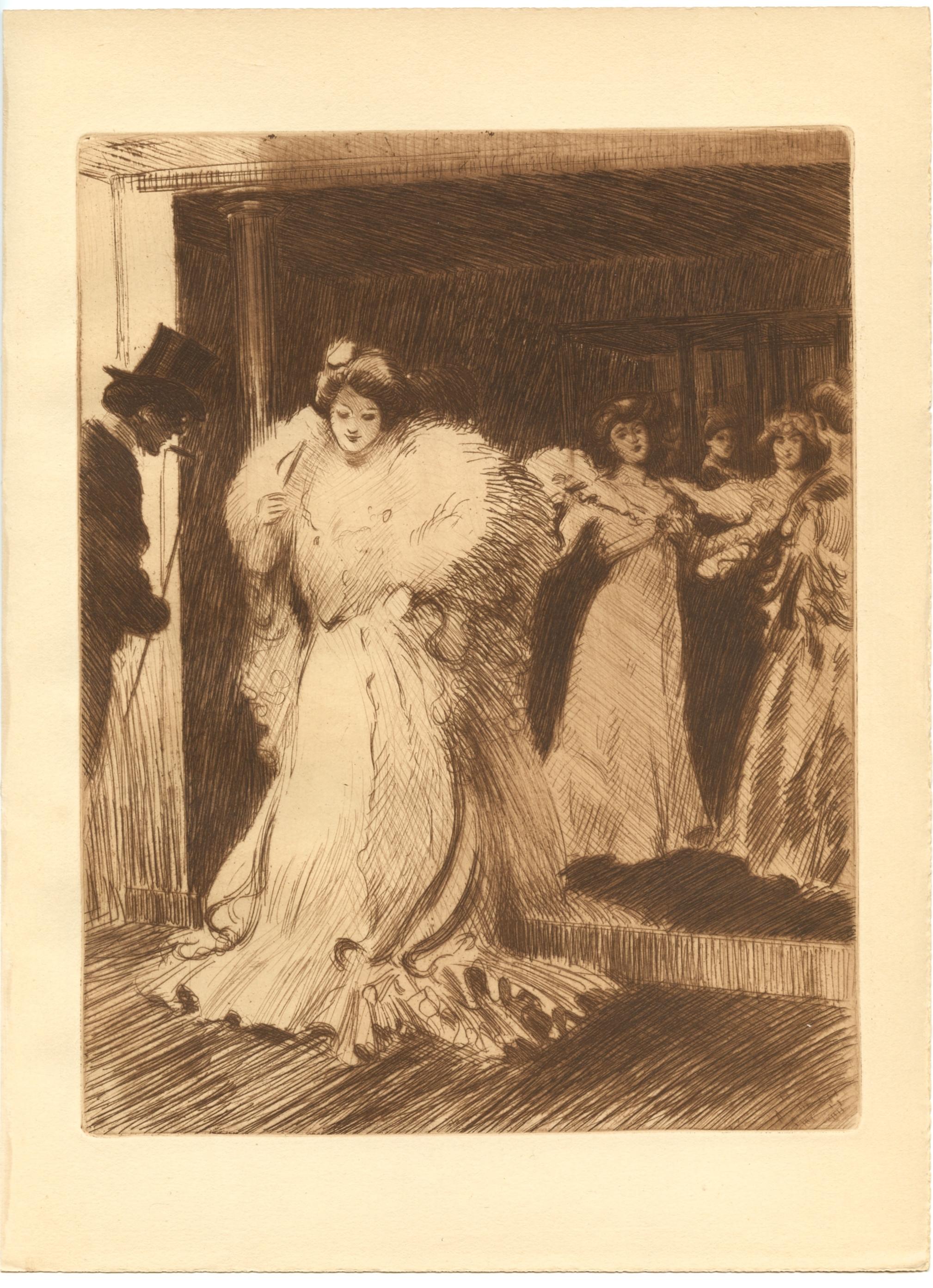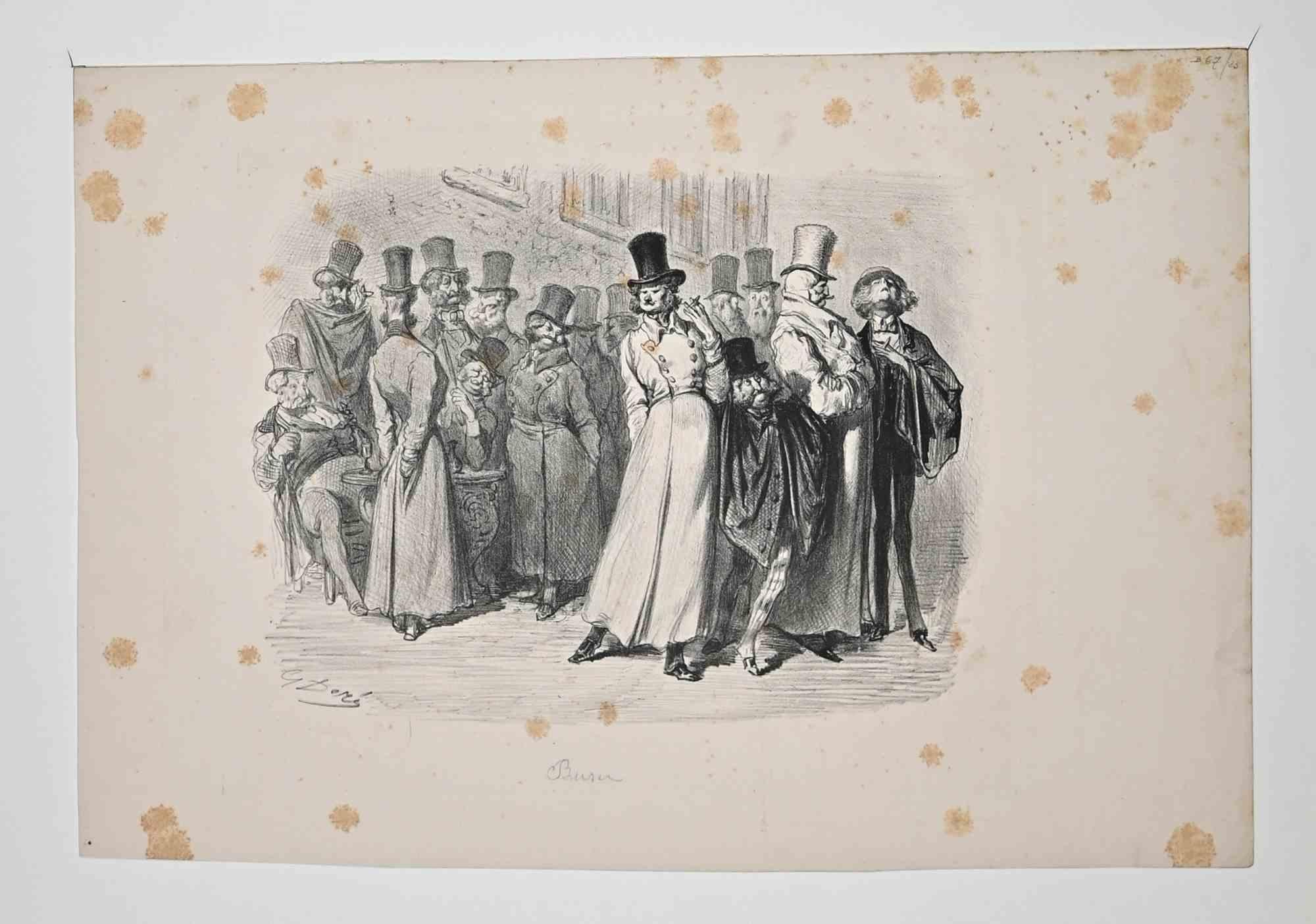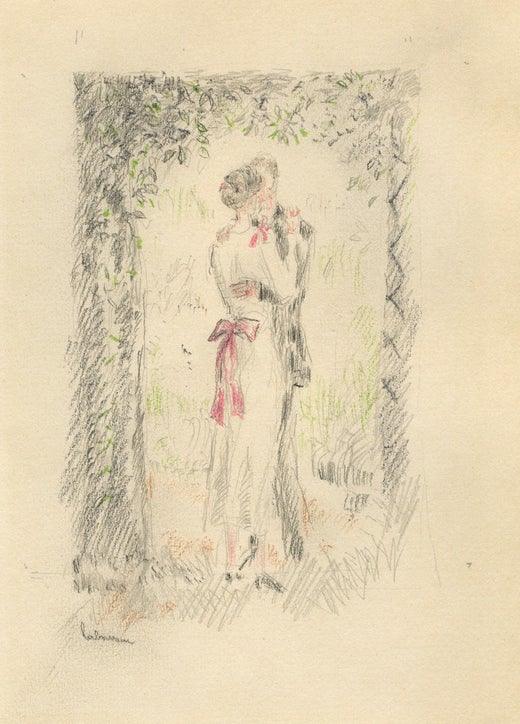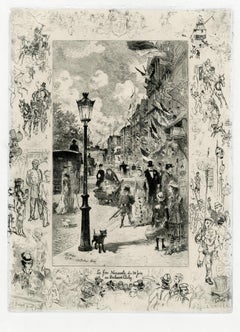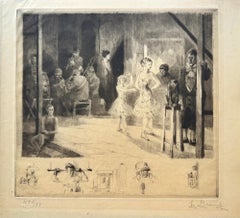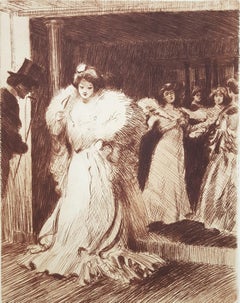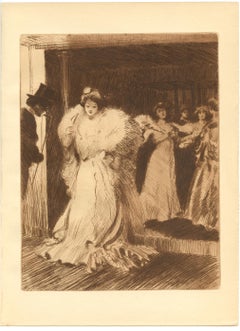Items Similar to Sortie de Theatre a Londres
Want more images or videos?
Request additional images or videos from the seller
1 of 2
Jean-Emile LaboureurSortie de Theatre a Londres1911
1911
$1,300
£985.73
€1,138.50
CA$1,823.98
A$2,031.87
CHF 1,071.78
MX$24,637.08
NOK 13,634.60
SEK 12,701.49
DKK 8,501.65
About the Item
Jean-Emile Laboureur (1877-1943), Sortie de Theatre a Londres, etching and drypoint, 1911, signed in pencil lower left [also signed and dated in the plate upper right]. Reference: Laboureur 104, third state (of 3). Published for La Societe des amis de l’eau-forte, with the blindstamp with the inscription: Circle Librairie Estampes. From an edition in the third state of 109; there were also 5 impressions of the first state and five of the second state. In excellent condition, the full sheet with deckle edges bottom and sides, 6 3/4 x 14; a remarque lower left 2 x 3 1/2, the sheet 12 3/4 x 19 3/4 inches.
Provenance: unknown collector’s mark verso (GOE in oval)
A fine rich impression, printed in dark brown ink on cream laid paper with the Arches watermark.
The small remarque lower left is actually another print printed on a separate plate; it shows a man running after a London horse-drawn trolley.
Although Sortie is dated 1911 Laboureur apparently drew the model for this etching much earlier, in 1909 or late 1908. In the autumn of 1908 he took up residence in London, occupying a space in Chelsea. One can discern a modernist approach entering his work here, and also perhaps some of the English penchant for satire and exaggeration, as exemplified in the work of Hogarth and Rowlandson – certainly the characters, especially the women leaving this theatre are, in Laboureur’s rendering, larger than life.
- Creator:Jean-Emile Laboureur (1877-1943, French)
- Creation Year:1911
- Medium:
- Movement & Style:
- Period:
- Condition:
- Gallery Location:New York, NY
- Reference Number:1stDibs: LU51531453943
Jean-Emile Laboureur
Jean Émile Laboureur, born in Nantes on 16 August 1877 and died in Kerfalher in Morbihan on 16 June 1943, was a French painter, draughtsman, engraver, aquafortist, lithographer and illustrator. Author of numerous engravings with burin, in individual plates or for books, he illustrated nearly eighty books, often by contemporary authors such as André Maurois, Jean Giraudoux, Colette, André Gide, Paul-Jean Toulet, Maurice Maeterlinck or François Mauriac. A painter of genre paintings, landscapes, animated or not, still lifes, he also created some frescoes and sculptures. His works are kept in several national and provincial museums. He founded or chaired associations of independent artists.
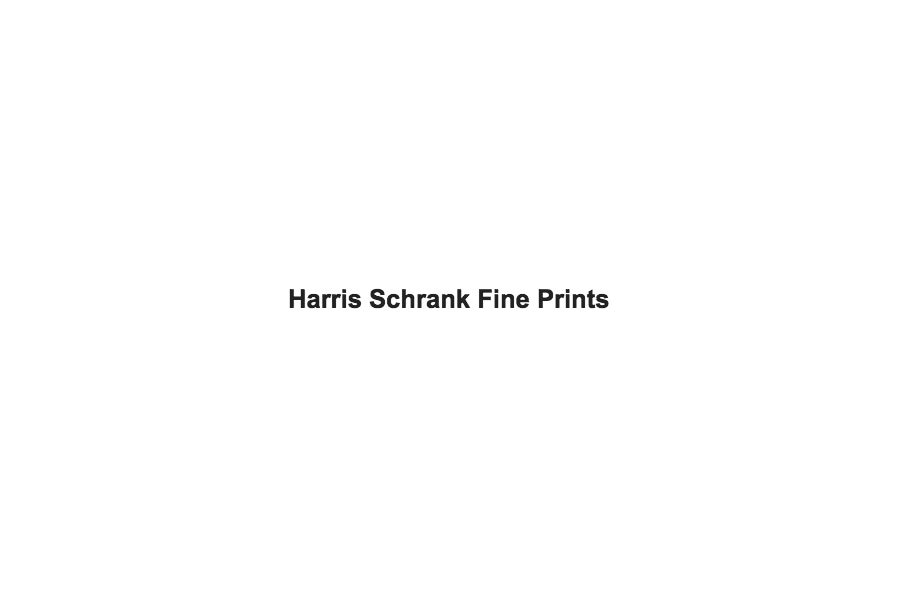
About the Seller
4.9
Recognized Seller
These prestigious sellers are industry leaders and represent the highest echelon for item quality and design.
Gold Seller
Premium sellers maintaining a 4.3+ rating and 24-hour response times
Established in 2000
1stDibs seller since 2016
106 sales on 1stDibs
Associations
International Fine Print Dealers Association
- ShippingRetrieving quote...Shipping from: New York, NY
- Return Policy
Authenticity Guarantee
In the unlikely event there’s an issue with an item’s authenticity, contact us within 1 year for a full refund. DetailsMoney-Back Guarantee
If your item is not as described, is damaged in transit, or does not arrive, contact us within 7 days for a full refund. Details24-Hour Cancellation
You have a 24-hour grace period in which to reconsider your purchase, with no questions asked.Vetted Professional Sellers
Our world-class sellers must adhere to strict standards for service and quality, maintaining the integrity of our listings.Price-Match Guarantee
If you find that a seller listed the same item for a lower price elsewhere, we’ll match it.Trusted Global Delivery
Our best-in-class carrier network provides specialized shipping options worldwide, including custom delivery.More From This Seller
View AllCoin de Rue Dans Soho
By Jean-Emile Laboureur
Located in New York, NY
Jean-Emile Laboureur (1877-1947), Coin de Rue Dans Soho, woodcut, 1909, signed in pencil lower left and numbered (15/15) [also initials in the plate]. Reference: Sylvain Laboureur 64...
Category
Early 1900s Modern Landscape Prints
Materials
Woodcut
Souper a New York
By Jean-Emile Laboureur
Located in New York, NY
Jean-Emile Laboureur (1877-, Souper a New York, etching on zinc, 1907, signed in pencil bottom left margin; also annotated “No 11/20 imp” bottom margin. Reference: Sylvain Laboureur ...
Category
Early 1900s French School Figurative Prints
Materials
Etching
Fashion Plates (a collection of 12)
By Paul Gavarni
Located in New York, NY
Paul Gavarni (1804-1866), Fashion Plates (a collection of 12), lithographs, c. 1840, as published in Le Charivari, with the letterpress verso. [Some are ...
Category
1840s Figurative Prints
Materials
Lithograph
Montparnasse Street
By Howard Norton Cook
Located in New York, NY
Montparnasse Street– 1931, Etching
Duffy 128. Edition 50, only 25 printed. Signed, dated, and annotated imp and 50 in pencil.
Image size 4 7/8 x 9 7/8 inches (124 x 251 mm); sh...
Category
1930s American Realist Landscape Prints
Materials
Etching
At the Show
By Jerome Myers
Located in New York, NY
Jerome Myers (1867-1940), At the Show, etching and drypoint, c. 1920, signed in pencil lower right. In good condition, with margins (paper losses upper corners), faint ink marks and ...
Category
1920s American Realist Figurative Prints
Materials
Drypoint, Etching
Le Ferveur
By Jean-Emile Laboureur
Located in New York, NY
Jean-Emile Laboureur (1877-1943), Le Ferveur, etching, engraving, roulette, drypoint, 1928, signed in pencil lower left, numbered lower right, and annotated “imp.” Reference: Laboure...
Category
1920s Realist Landscape Prints
Materials
Engraving, Etching
You May Also Like
La Fête Nationale du Boulevard Clichy
By Félix Hilaire Buhot
Located in Fairlawn, OH
La Fête Nationale du Boulevard Clichy
Etching, drypoint, and aquatint, 1878
Signed lower left in the plate (see photo)
Printed chine collee, mounted on white wove paper
Upper plate m...
Category
1870s French School Figurative Prints
Materials
Etching
La Parade
By Auguste Brouet
Located in Middletown, NY
Etching on wove Japon paper, 8 5/8 x 9 1/4 inches (219 x 235 mm), wide margins. Signed, titled, and numbered 6/75 in pencil, lower margin, and with the Dietrich & Cie éditeurs blinds...
Category
Early 20th Century French School Interior Prints
Materials
Handmade Paper, Etching
L'Avant-Foyer de l'Opera /// French Impressionist Etching Figurative Lady Man
By Tony Minartz
Located in Saint Augustine, FL
Artist: Tony Minartz (French, 1873-1944)
Title: "L'Avant-Foyer de l'Opera"
Portfolio: Revue de l'Art Ancien & Moderne
*Issued unsigned
Year: 1903
Medium: Original Etching on cream laid paper
Limited edition: Unknown
Printer: Unknown
Publisher: Revue de l'Art Ancien & Moderne, Paris, France
Framing: Recently framed in a traditional gold and black moulding with 100% cotton rag matting
Framed size: 18.63" x 16.38"
Sheet size: 12" x 9"
Image size: 9" x 7.25"
Condition: In excellent condition
Notes:
Printed in one color: bistre.
This review was founded in 1897 in the continuity of the review Les Beaux-Arts published between 1861 and 1865; Jules Comte, the founder, entitled his first issue Les Beaux-Arts - Revue nouvelle then changed the title to La Revue de l'art ancien et moderne. Jules Comte directed the review until his death in 1912. Raymond Woog took over , who was provisional director until the start of the war in July 1914. In 1919, André Dezarrois took over this review and was its director until December 1937, date of last issue (published in January 1938). In the meantime, it publishes the Bulletin of ancient and modern art, which has gained a certain notoriety in the community.
Biography:
Tony Minartz, pseudonym of Antoine Guillaume, born 8 April 1873 to Cannes and died in that city on 13 December 1944 Is a painter, draftsman , illustrator and engraver French.
Painter autodidact , Tony Minartz starts to become known in 1896 by exhibiting paintings at the Salon of the National Society of Fine Arts , and then decorates the Pompadour theater of painted panels for fashion shows " Grand Guignol ", directed by L. Darthenay. In 1903, Henri Béraldi , with whom he worked, praised him in The Journal of ancient and modern art, writing that "it was thirty years ago," and he has received advice from Paul Renouard to be formed the technique of etching ; Béraldi adds that his favorite subjects are "Paris at night Paris at night, always." Minartz also gives them some high-remarkable in The Journal of ancient and modern art until 1910: balls, cafe concerts, Parisian in their most beautiful dresses, but also music-halls, music halls, restaurants, large and small theaters, are the preferred settings of his compositions.
Its fertile period seems to end in 1914. In addition to the National Salon, Minartz exhibited in Paris at the gallery Bartholomew (1903), the Independent Living (1905, 1906) and the gallery Devambez (1909) and received the Academic Palms . He occasionally collaborates with periodic illustrated as The Almanac Sports (Ollendorff, 1899), or satirical as Gil Blas...
Category
Early 1900s Impressionist Figurative Prints
Materials
Laid Paper, Intaglio, Etching
"L’Avant-foyer de l’Opera" original etching
By Tony Minartz
Located in Henderson, NV
Medium: original etching. This impression on laid paper was printed in 1903 and published in Paris for the Revue de l'art ancien et moderne. Plate size: 9 x 7 inches (228 x 178 mm). ...
Category
Early 1900s Prints and Multiples
Materials
Etching
Parisian - Lithograph by Gustave Dorè - 1854
By Gustave Doré
Located in Roma, IT
Parisian is aLithograph realized by Gustave Dore in 1854.
Good conditions except for some foxings.
Hand-singed.
The artwork is depicted in a well-balan...
Category
1850s Modern Figurative Prints
Materials
Lithograph
Les Étudians de Paris - Original Lithograph by Paul Gavarni - 1847
By Paul Gavarni (Guillaume Sulpice Chevalier)
Located in Roma, IT
Amusing original colored lithograph with pouchoir details.
Beautiful satiric illustration by the French draftsman Paul Gavarni (alias Guillaume Sulpice Chevalier Gavarni, 1804-1866...
Category
1840s Modern Figurative Prints
Materials
Lithograph
More Ways To Browse
3 Horses Plate
Hogarth Etching
Maurice Andre Tapestry
Nara Lithograph
Norwegian Cups
Original Louis Icart
Pablo Picasso Picador
Philips Galle
Picasso Paix
Picasso Picador
Picasso Reclining Nude
Picasso Three Musicians
Seeded Glass Table
Steinlen Original
Studio Else Paul
Vintage Nurse Posters
1950s Vintage Suitcase
1950s Suitcase
